Who said this is the darkest time of the year? Where I live, hell’s on the loose.
It’s the carnival season (the “fifth season”), which ends the day before Lent. A time of exuberant colours, elaborate masks and ingenious costumes, a time of feasting, singing, and hanging out together with the fellowship.
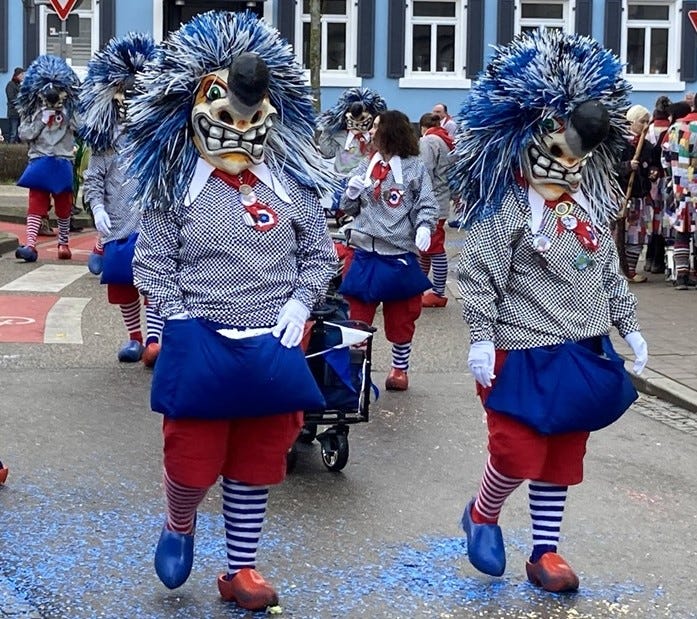

What are the highlights of the carnival season?
I thought for many years the carnival was just a pretext for week-long excessive drinking, merrymaking and fooling around. It turns out, though, that it follows a thought-provoking script about the world turning upside down. What is even more thought-provoking, I now find, is what it tells about how our human mind ticks.
The Fasnacht, or Fasnet, as it’s called here, in the Swabian-Alemannic space, which includes German-speaking Switzerland, starts with Epiphany on the 6th of January. The Narren (jesters, fools, loonies) take to the streets with dusters and brooms, cleaning and preparing their outfits. They rattle their ratchets and crack their whips to warn that their time is coming.
They call out Narri Narro, or huhuhu: a city bus displayed the other day the words Narri Narro, with blinking letters, instead of its destination.
The streets go quiet afterwards, with jester reunions in community halls at weekends, until the so-called Dirty Thursday, when the real feast begins. “Dirty” as in oily, buttery, fried, stewed — loads of eating, therefore.
This is the final week before the long fasting time of the Lent, so butchers and farmers in the past had to sell as much as they could and make sure no supplies were left that could go off.
Early morning, before sunrise, figures dressed in nightgowns and nightcaps haunt the streets together with fanfare bands to wake the town. Later that day, schools and city halls come under attack and are taken over by the Narren. The jesters’ tree is set up in the afternoon, and the first parades begin in the evening.
The fun goes on over the weekend, including a kids’ festival, usually on Sunday.
The next milestone, though, is Shrove Monday. That’s when the grand parades and so-called Jesters’ Leap take place. The jesters are costumed as wild animals, devils, witches, or various characters, and there’s a demonstrative but playful meanness or evil.
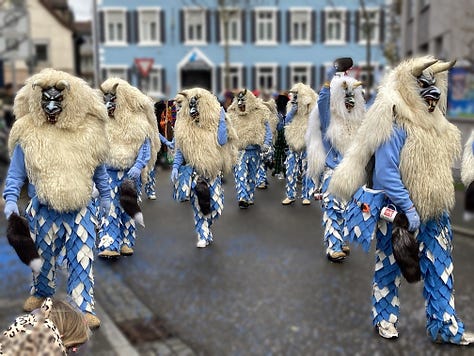

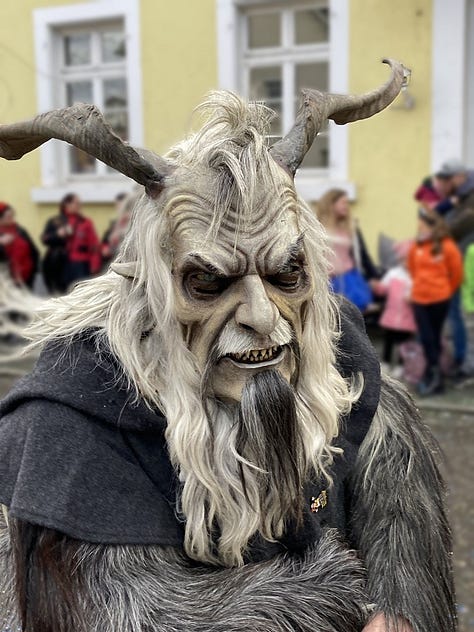
The jesters often mingle with the spectators on the side, rubbing their hair with confetti or telling those they know what a pain in the neck they are (without revealing their own identity, of course). And yet, candy and chocolates are being hurled out into the crowd, to the kids’ delight. (In Cologne, the parade borders on caricature, with very explicit messages to the politicians of the day.)
Shrove Monday, perhaps more than the rest of the season, is very local: towns have their own jester fellowships, and the festivities include specific costumes and activities.
For example, in Rottweil, the oldest town in Baden-Württenberg, with over 2000 years of history, the parade is famous for the elaborate masks that embody characters with their own name, such as Jack with feathers, Biss, Gschell, or Fringe Dress.
In Schramberg, Shrove Monday’s highlight is the challenge of going down the mountain river in improvised contraptions while keeping your feet dry.
In Löffingen, the attraction is after sunset, when the witches go wild in a special edition of the Walpurgis Night.
Tuesday may repeat the parades of the day before, or may already herald the end of the festival: the Fasnet straw puppet is burned and buried, and the jesters’ tree is taken down. On Ash Wednesday, the wallet is washed, as it’s empty after the days of feasting, and the keys are handed back to the city hall.
Where does the Fasnacht come from?
The jesters claim the Fasnacht is a pre-Christian tradition of driving winter away and celebrating the upcoming spring. Historians and ethnologists, however, are clear about the origins of this festival: it’s a Christian tradition related to the beginning of Lent.
Fasnacht means the “night” before “fasting”. Carnival stems from the medieval Latin carnem levare or carnelevarium, meaning “remove meat” or “saying goodbye to meat”.
Historically, the tradition of feasting and celebrating in various costumes goes back to the Middle Ages. As the Church saw in these festivities a manifestation of the devil, the people responded in defiance by dressing as devils, witches and wild animals. The Jester figure was created, with an entire array of underworld companions.
Reformation prohibited the Fasnacht, so these traditions died out at the end of the 18th century. Carnival revived on the wave of Romanticism, and it was in 1823 that the first Shrove Monday parades were held in Cologne. Over the 19th century, the carnival created sophisticated figures, such as Prince Carnival, and replaced the old tavern meetings with street processions.
The medieval jester costumes and traditions were archived until the early 20th century, when the Fasnacht developed as a return to the original festivities of the common people. Since then, the Fasnacht (in Germany’s Southwest) and the Carnival (Germany’s Lower Rhine region, notably around Cologne) went asunder1.
Interestingly, the number of jester fellowships has increased from 40 in 1924 to over 1700 nowadays in the entire Southwest. Over a thousand were set up in the past thirty years. Not all that looks old is old, mind you.
What story does the Fasnacht tell?
The first thing that comes to mind is the spirit of defiance, the rebellion against rule, the biting back against authority that is the essence of this festival. It’s the coming out of an uncomfortable truth, the dusting and cleaning of the old, the conquering, the expansion and explosion of energies, both destructive and creative, held captive underground.
It’s a polarity story about the dark side taking over the mundane world.
Only the dark side is actually vivid and colourful. It almost prompts us to think that morals, rule, rationality may well serve a purpose day by day, but what opposes them need not be dark, wild, or evil — only a distinct paradigm which inevitably claims its place within us.
A paradigm we might need to integrate into who we are, beyond the occasional, short-lived rebellion.
Panning out, the Fasnacht is a modern myth, a story retold, in more than one way.
The origins of the tradition stray, in the telling of Fasnacht actors and fans, from the historical fact. People claim their festival to be ancestral, therefore deeper than any institutional order.
It’s also a story retold by turning an impulse to eat and drink excessively before the long weeks of abstinence into a myth of the dark world claiming its rule. In other words, by rationalizing an outburst of chaos as an ancient natural rite.
Finally, it’s a drive to create a myth by amplifying a tradition that may not have been so powerful and omnipresent as it is today.
Let me be clear: it’s not so much about turning a tradition to commercial profit, as is the case with Christmas.
It’s also not primarily about a tradition exploited for yet more abundant merrymaking: the jester fellowships are earnest about their mission of keeping their tradition alive.
It’s about actively creating instead of just maintaining a tradition. The Fasnacht is for the most part a tale, one that we need in our quest for myths and roots. Because roots generate coherence, and coherence creates meaning and belonging.
So, turning back to ourselves: what we take for a given is often just one of the possible stories. The individual past, like the collective one, can be retold.
What stories are we telling ourselves about life, what is right or wrong, who we are, and what we should achieve? What script does our life follow, what character or figure do we embody? What is our “elevator pitch”?
Is the way we enact this character the only one possible? Is this the best story we can choose for ourselves?
As without, so within: what of the Fasnacht goes on inside us? What claims back its rule every now and then? What uncomfortable truths are being spoken out in these hiatus moments? What mask and costume are we wearing during the chaos?
Or are we wearing them throughout the year?
That’s also why in Cologne, the carnival season officially starts on 11 November at 11.11, while here, it begins on 6 January.






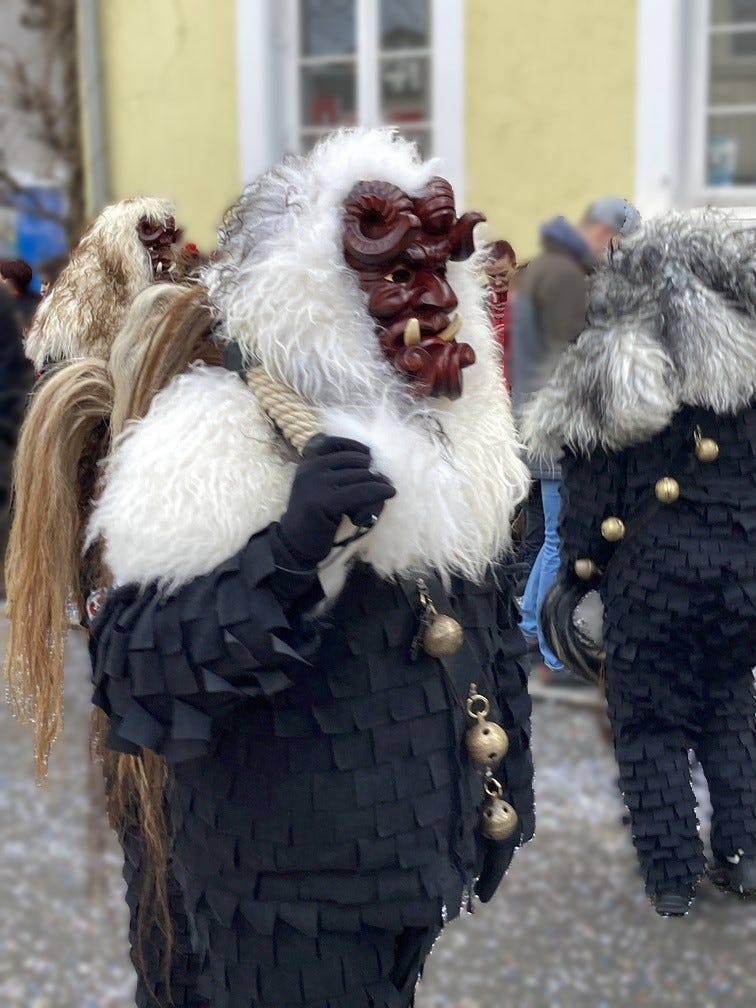

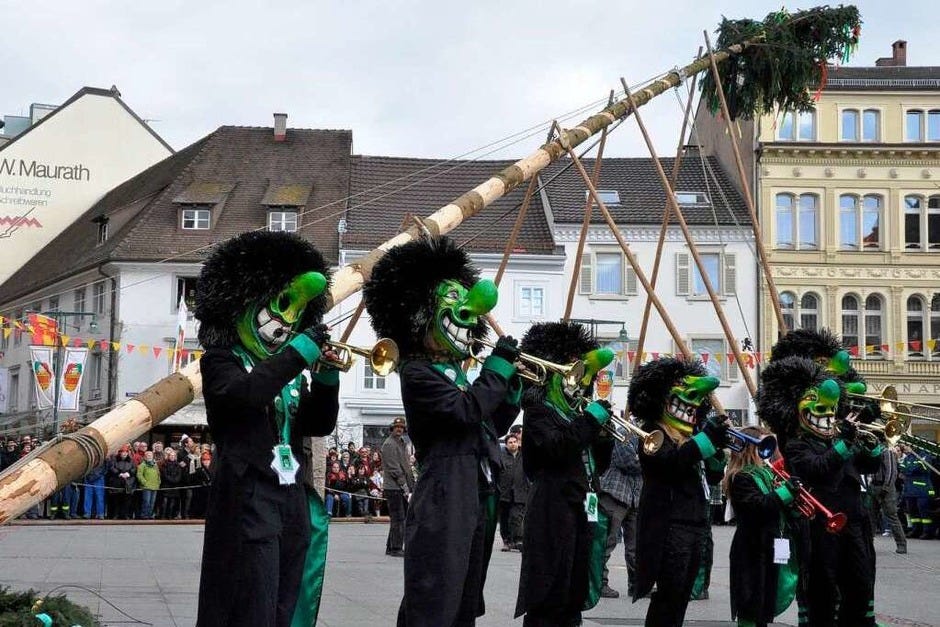
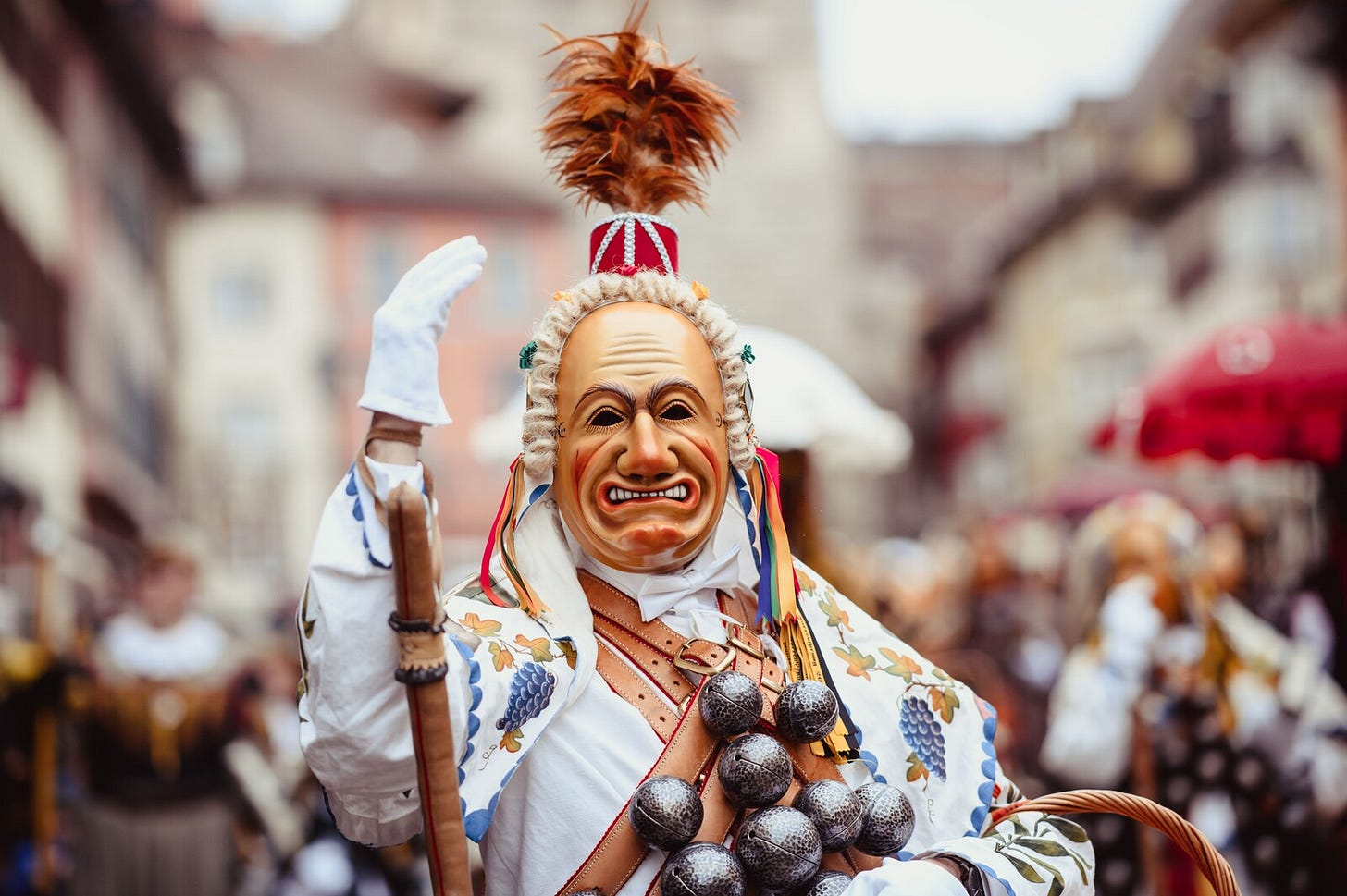
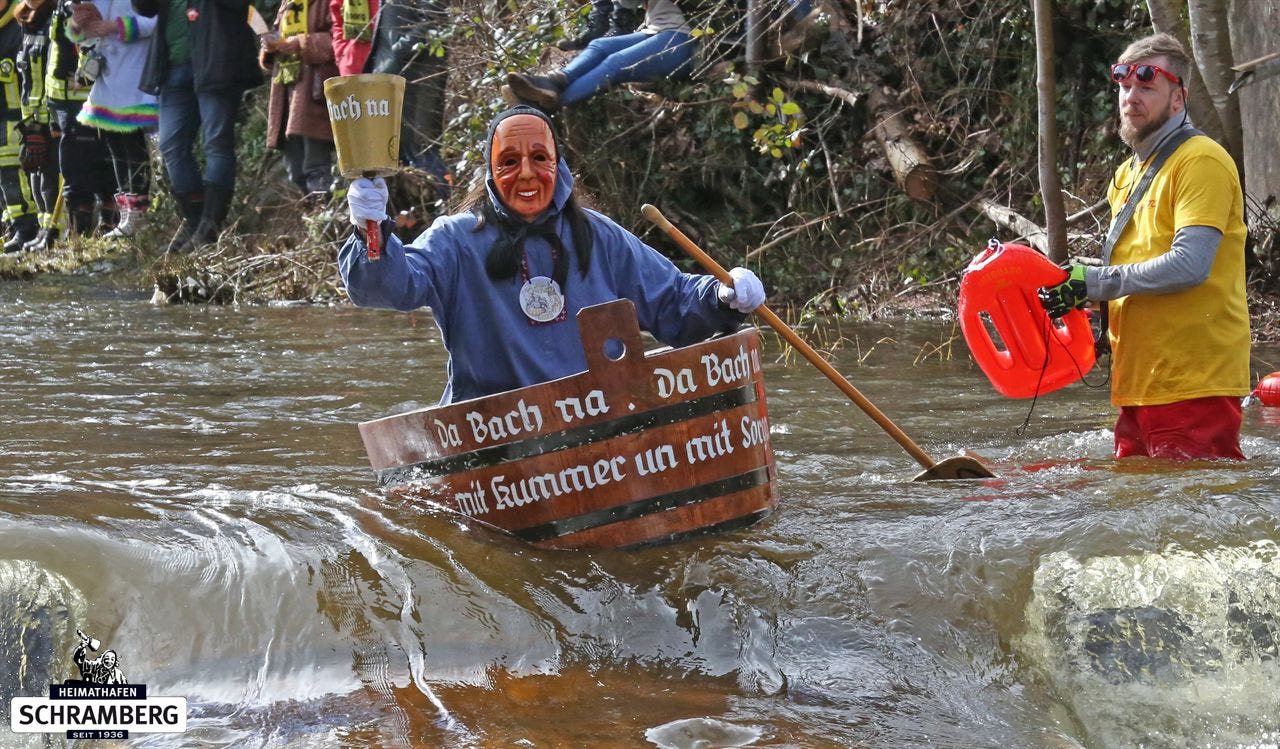
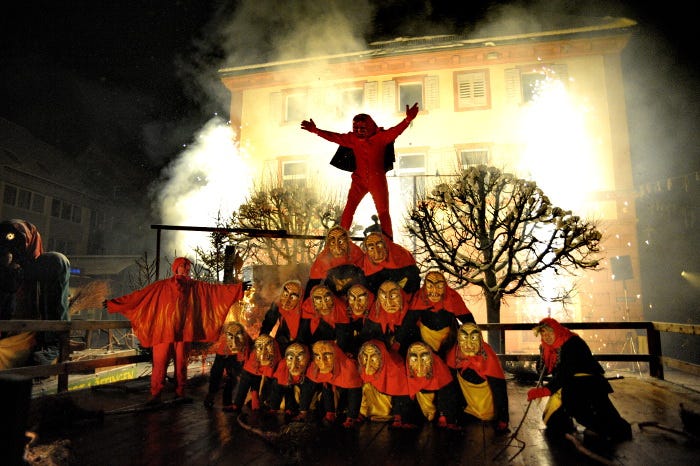
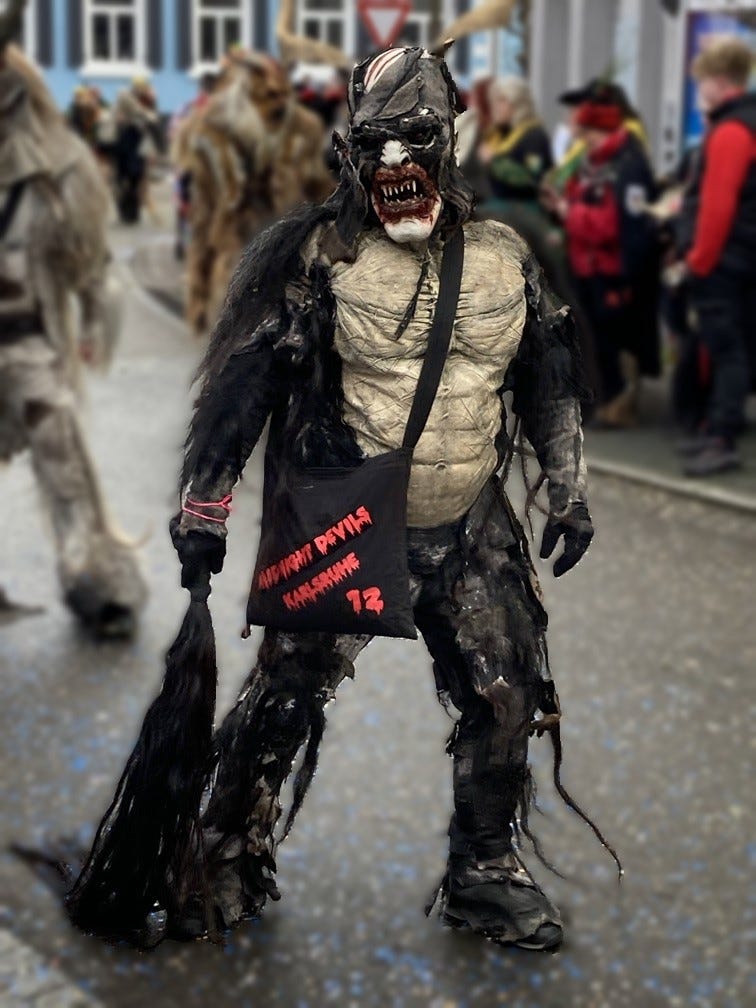


Zoe, I truly loved this post. This below, is pure gold:
What we take for a given is often just one of the possible stories. The individual past, like the collective one, can be retold.